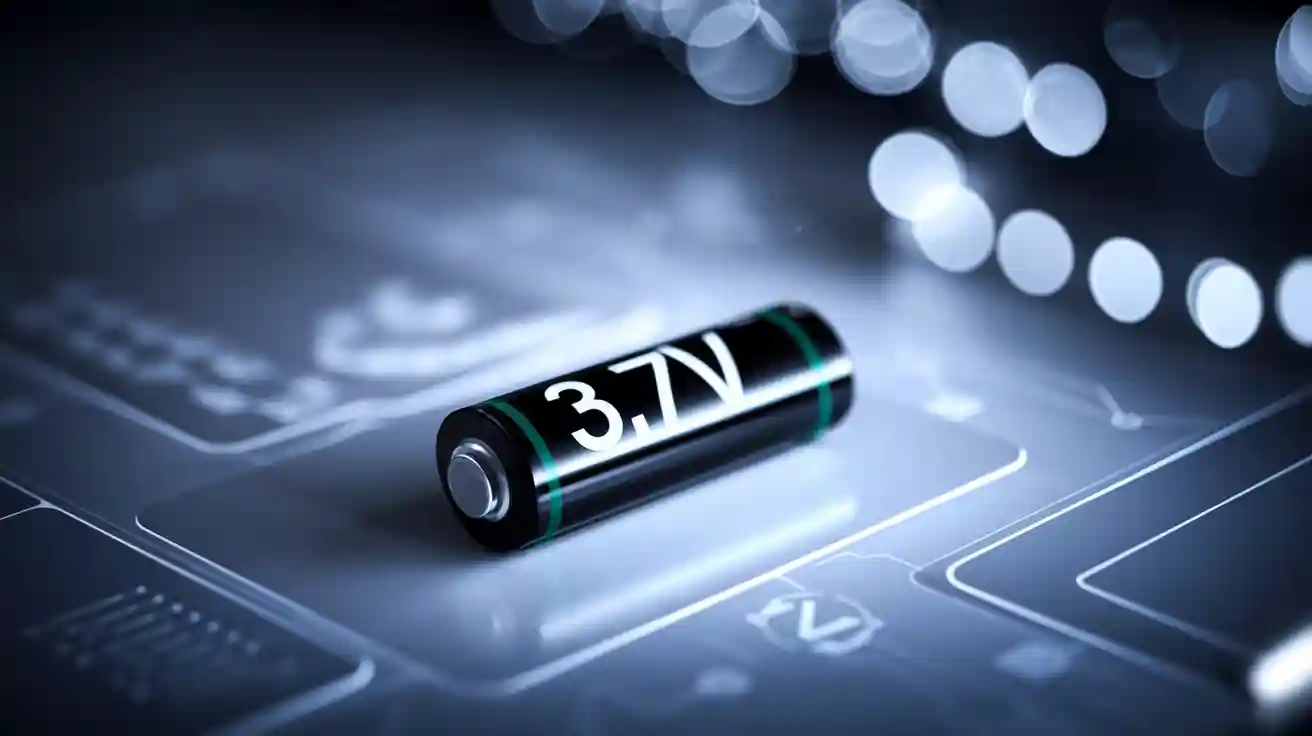
Die 3,7V Standardspannung in a lithium-ion battery comes from the unique chemistry between lithium cobalt oxide and graphite electrodes. This voltage is not random. Instead, it results from the electrochemical properties of these materials. The 3.7V standard voltage shapes battery design and system requirements, giving lithium-ion battery cells higher energy density and longer runtime per charge. Devices like smartphones, electric vehicles, and portable electronics rely on this rechargeable battery chemistry for efficient, lightweight power. The 3.7V standard voltage also drives the global market for rechargeable battery technology, as shown in the nachstehende Tabelle:
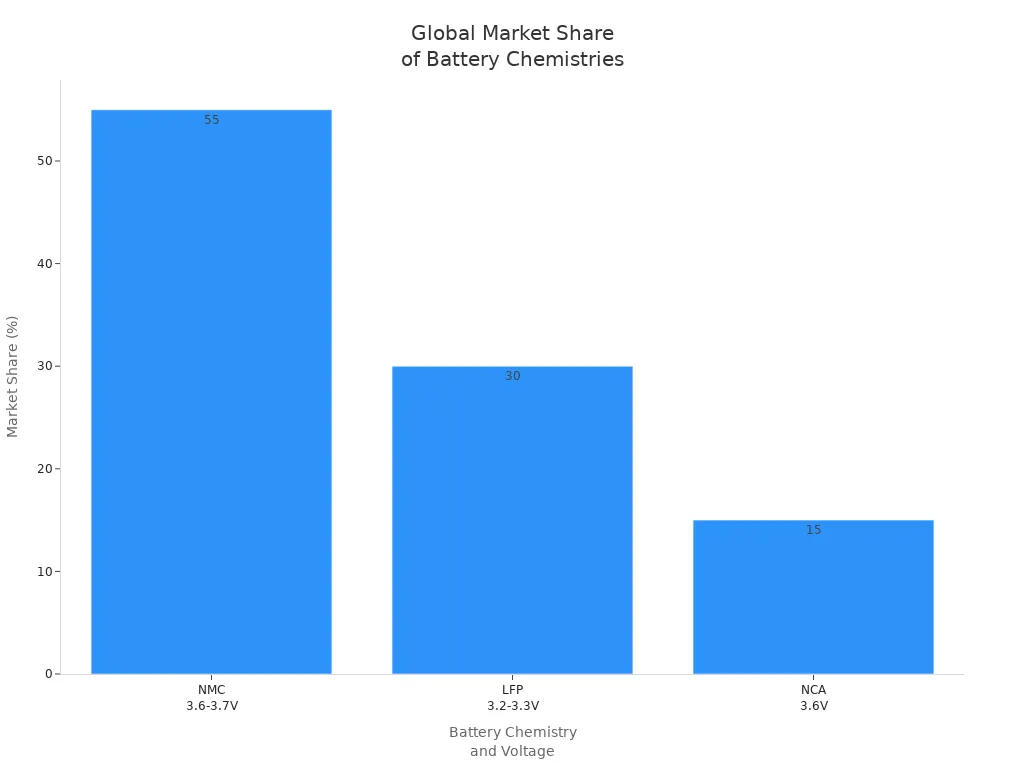
Understanding why this voltage matters helps explain battery safety, device compatibility, and battery design choices that shape the rechargeable technology used every day.
3.7V Standard Voltage Explained
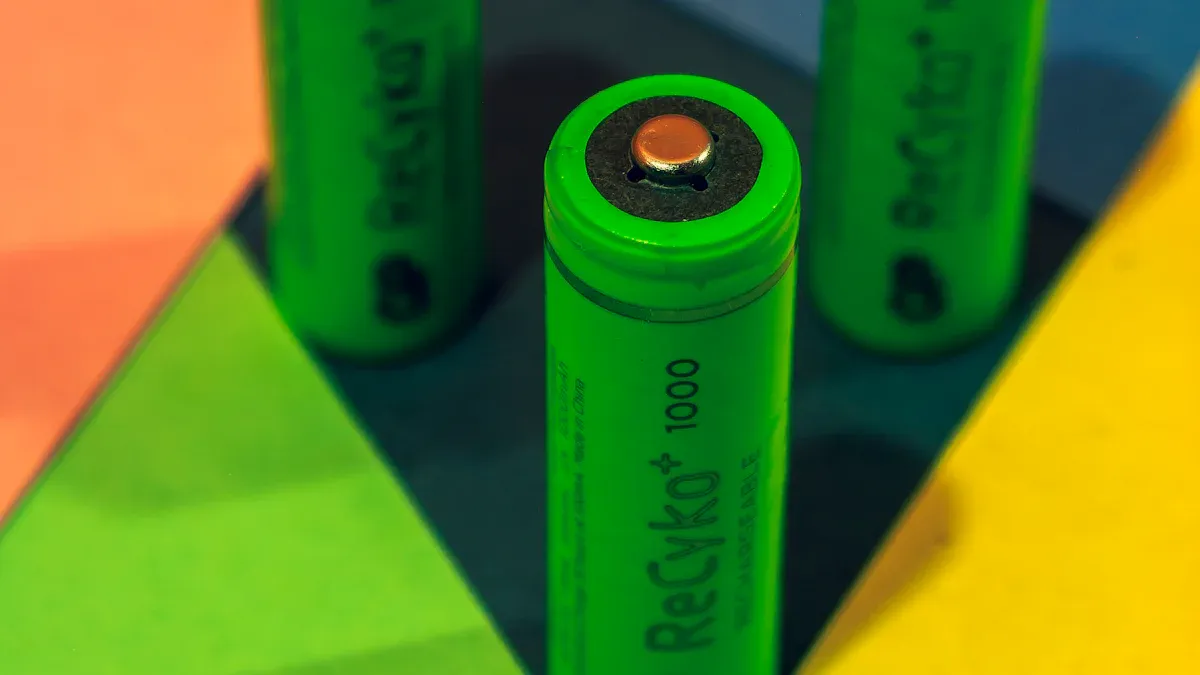
Nominal vs. Maximum Voltage
The 3.7V standard voltage in a lithium-ion battery is known as the nominal voltage. This value represents the average voltage during the battery’s discharge cycle. Engineers use nominal voltage to design devices and battery packs because it simplifies calculations and ensures compatibility.
- Nominal voltage is not a fixed value. It is an average that helps users and engineers understand how the battery will perform during most of its use.
- The actual voltage of a lithium-ion battery changes depending on how much charge it has, how much current it delivers, the temperature, and the battery’s age.
- Nominal voltage is important for standardization. It allows different batteries and devices to work together safely and efficiently.
- Battery packs use nominal voltage to determine how many cells to connect in series. For example, three cells with a 3.7V standard voltage create a pack with 11.1V.
Die table below compares the nominal, maximum, and minimum voltages for common lithium-based batteries:
| Chemie | Nennspannung (V) | Maximum Voltage (V) | Minimum Voltage (V) |
|---|---|---|---|
| LiCoO2 (Lithium Cobalt Oxide) | 3.6 – 3.7 | 4.2 | 3.0 |
| LiFePO4 (Lithium Iron Phosphate) | 3.2 | 3.6 | 2.5 |
Anmerkung: The nominal voltage is the average operating voltage. The maximum voltage is the highest safe charge level, and the minimum voltage is the lowest safe discharge level. Staying within these limits protects the battery and extends its lifespan.
A lithium-ion battery usually starts at its maximum voltage when fully charged, which is about 4.2V. As the battery discharges, the voltage drops. When the voltage reaches the minimum safe level, usually around 3.0V, the battery needs recharging. The 3.7V standard voltage sits between these two points and reflects the battery’s typical performance during use.
Why 3.7V Is Chosen
The 3.7V standard voltage is not random. It comes from the chemistry inside the lithium-ion battery, especially the combination of lithium cobalt oxide as the cathode and graphite as the anode. This chemistry creates an electrochemical potential difference that averages out to about 3.7V during normal use.
- The 3.7V standard voltage matches the average voltage at about 50% state of charge for lithium-ion batteries. This value gives a good balance between energy, safety, and battery life.
- The 3.7V standard voltage allows for high energy density, which means the battery can store more energy in a smaller space. This makes lithium-ion batteries ideal for portable and rechargeable devices.
- Many electronic components and battery management systems are designed to work with the 3.7V standard voltage. This simplifies device design and manufacturing.
- The 3.7V standard voltage also supports modular battery pack designs. Multiple cells can be connected in series to create higher voltages for larger devices, such as electric vehicles or power tools.
- The global adoption of the 3.7V standard voltage has led to mass production, lower costs, and a reliable supply chain for lithium-ion batteries.
Not all lithium batteries use the 3.7V standard voltage. For example, lithium iron phosphate (LiFePO4) batteries have a nominal voltage of about 3.2V. This lower voltage comes from their different chemistry, which offers greater safety and longer cycle life but less energy density compared to standard lithium-ion batteries.
| Batteriechemie | Nennspannung | Volle Ladung Spannung | Discharge Voltage Range |
|---|---|---|---|
| Li-ion (standard) | 3.7V | 4.2V | 3.0V – 4.2V |
| LiPo | 3.7V | 4.2V | 3.0V – 4.2V |
| 18650 | 3.7V | 4.2V | 2.5V – 4.2V |
| LiFePO4 | 3.2V | 3.6V | 2.5V – 3.6V |
The 3.7V standard voltage gives lithium-ion batteries a flat voltage profile during discharge. This means the battery delivers steady energy for most of its cycle, unlike other rechargeable batteries such as nickel-cadmium or lead-acid, which show a sharp drop in voltage as they discharge. This steady voltage output helps devices run smoothly and efficiently.
Maintaining a stable 3.7V standard voltage throughout the battery’s life can be challenging. The voltage naturally changes as the battery charges and discharges. Overcharging above 4.2V or deep discharging below 3.0V can damage the battery, reduce its energy capacity, and shorten its lifespan. Battery management systems play a key role in monitoring and controlling voltage to keep the battery safe and reliable.
Lithium-Ion Battery Chemistry
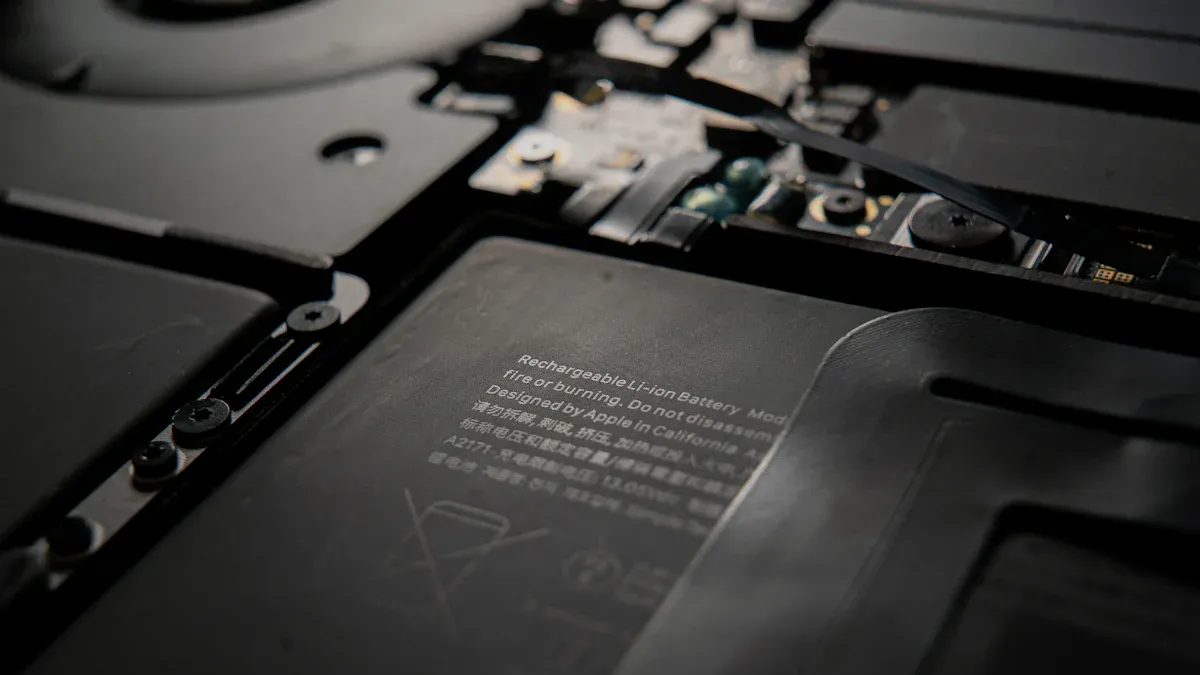
Electrode Materials
The lithium-ion battery gets its standard voltage from the special properties of its electrode materials. The most common combination uses lithium cobalt oxide as the cathode and graphite as the anode. These materials create a difference in electrochemical potential that sets the voltage near 3.7V.
- The lithium cobalt oxide cathode has an electrode potential of about 3.9–4.0V.
- The graphite anode has a much lower potential, around 0.1–0.2V.
- The lithium ions move between these two electrodes during charging and discharging, which allows the battery to store and release energy.
- The voltage of the lithium-ion battery comes from the difference between the cathode and anode potentials.
This setup gives the lithium-ion battery a balance of energy density, stability, and safety. Higher voltages can provide more energy but may reduce safety. Lower voltages make the battery safer but lower its energy density. The 3.7V standard voltage works well for most devices because it offers a good mix of these qualities.
Die layered structure of lithium cobalt oxide lets lithium ions move in and out easily. This movement is called reversible intercalation. It helps the battery last longer and keeps the voltage stable during use.
Different battery chemistries use different materials, which changes the voltage. For example, lithium iron phosphate batteries use LiFePO4 as the cathode and have a lower Nennspannung of about 3.2V. The table below shows how the positive electrode material affects the nominal voltage:
| Akku-Typ | Material der positiven Elektrode | Nennspannung (V) |
|---|---|---|
| Lithium-Eisen-Phosphat (LiFePO4) | LiFePO4 | 3.2 |
| Ternäre Lithium-Batterie (NCM/NCA) | Lithium Nickel Cobalt Manganese Oxide | 3.7 |
| Lithium Cobalt Oxide (LiCoO2) | LiCoO2 | 3.7 |
| Lithium Manganese Oxide (LiMn2O4) | LiMn2O4 | 3.7 |
| Lithium Nickel Manganese Cobalt (NMC) | LiNiMnCoO2 | 3.6 – 3.7 |
| Lithium Titanate (Li4Ti5O12) | Li4Ti5O12 | 2.4 |
| Lithium Phosphate Manganese (LiMnPO4) | LiMnPO4 | 3.2 |
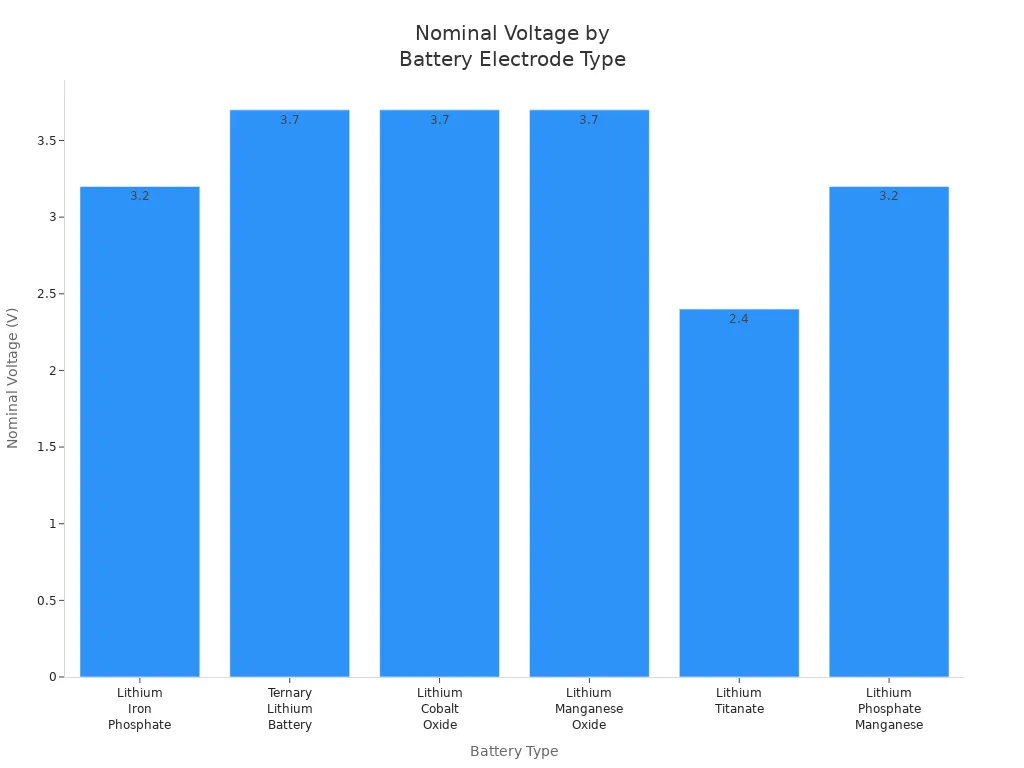
Voltage Curve and Energy Density
Die voltage curve of a lithium-ion battery shows how the voltage changes as the battery charges and discharges. This curve depends on how lithium ions move in and out of the electrode materials. When the battery charges, lithium ions leave the cathode and enter the anode. When the battery discharges, the ions move back to the cathode. This process is called intercalation.
The voltage curve is shaped by the way the Fermi levels of the electrode materials line up during charging and discharging. The external voltage matches the difference in these energy levels. Sometimes, the curve shows small drops or rises because of changes inside the battery, like phase boundaries or concentration gradients. These features can cause effects such as voltage hysteresis or memory effects.
The energy density of a lithium-ion battery tells how much energy it can store for its weight. Most lithium-ion batteries have an energy density between 120 and 170 Wh/kg. This high energy density makes them popular for portable electronics, electric vehicles, and many other uses. The battery can deliver steady energy for most of its cycle, which helps devices run smoothly.
However, there is a trade-off between energy density and cycle life. Batteries with higher energy density often have a shorter cycle life. For example:
| Batteriechemie | Nennspannung | Energiedichte (Wh/kg) | Zyklus Lebensdauer (Zyklen) | Key Trade-off / Notes |
|---|---|---|---|---|
| High-energy-density Li-ion | ~3.7V | 120–170 | 500–1000 | Higher energy density leads to faster degradation |
| LiFePO4 (LFP) | ~3.2V | 160–180 | 2000–4000+ | Lower energy density but much longer cycle life |
- Higher energy density batteries go through more intense chemical reactions, which can wear them out faster.
- High-energy-density lithium-ion cells usually last 500 to 1000 cycles.
- Lower-energy-density chemistries like LFP can last over 2000 cycles and sometimes more than 4000 cycles.
- LFP batteries have lower energy density but offer better safety and longer life.
Innerer Widerstand also affects the voltage stability and cycle life of a lithium-ion battery. As the battery ages or faces high temperatures, its internal resistance increases. This causes voltage drops under heavy loads, more heat generation, and faster capacity loss. The table below explains how internal resistance impacts battery performance:
| Aspekt | Effect of Internal Resistance | Example Battery Chemistry Impact |
|---|---|---|
| Spannungsstabilität | Increased internal resistance causes voltage drops (voltage sag) under high current loads, reducing power output and causing device shutdowns. | LiFePO4 maintains low resistance, supporting stable voltage; LCO and NMC show rapid resistance increase causing voltage instability. |
| Heat Generation | Higher resistance leads to more heat during charge/discharge, accelerating chemical degradation and capacity loss. | NMC batteries require cooling due to heat from resistance; LiFePO4 generates less heat, prolonging life. |
| Zyklus Leben | Resistance growth shortens battery lifespan by accelerating degradation. | LiFePO4: 2000–5000 cycles with low resistance; LCO: 500–1000 cycles with faster resistance increase. |
| Temperature Influence | High temperatures accelerate resistance growth; low temperatures increase charge transfer impedance, both affecting performance. | Resistance increases faster at high temps, reducing cycle life. |
| Monitoring & Management | Tracking internal resistance via capacity attenuation rate and DC resistance helps predict battery health and optimize performance. | Proper design and temperature control maintain low resistance, enhancing voltage stability and cycle life. |
Managing temperature, avoiding deep discharges, and using smart chargers help keep internal resistance low. This extends the battery’s life and keeps the voltage stable.
The lithium-ion battery stands out because it combines high energy density, a steady voltage curve, and good cycle life. The choice of electrode materials, the way lithium ions move, and the control of internal resistance all work together to make this possible. This balance is why the lithium-ion battery has become the standard for so many modern devices.
Battery Performance and Compatibility
Device Integration
The 3.7V standard voltage in a lithium-ion battery supports higher energy density, making it a strong choice for modern devices. This voltage allows each cell to store and deliver more energy than older chemistries like nickel-metal hydride. The table below shows how lithium-ion battery cells compare to NiMH batteries in voltage, energy density, and power density:
| Merkmal | NiMH Batteries | Lithium-Ion Batteries |
|---|---|---|
| Spannung pro Zelle | 1.25 V | Typically 3.7 V |
| Energy density | 55-110 Wh/kg | 100-300 Wh/kg |
| Power density | 100-500 W/kg | 500-5000 W/kg |
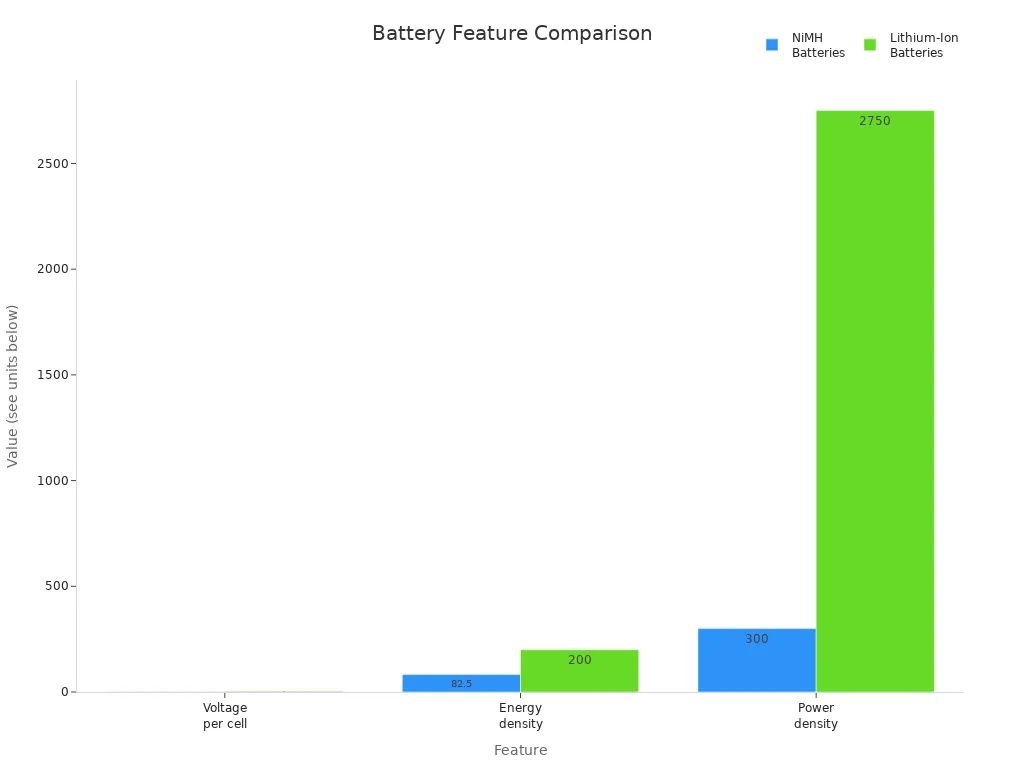
A lithium-ion battery with a 3.7V voltage fits the needs of many rechargeable devices. Device manufacturers select this battery because it matches the voltage range most electronics require. The higher energy density means devices can run longer on a single charge. Battery management systems help regulate voltage and prevent hazards, which improves battery safety and battery performance. The physical and chemical design of the battery, including the electrolyte and separator, ensures stable energy delivery and safety. Manufacturers also use protection circuit boards and custom connectors to match the battery to the device’s design. They follow strict certifications and standards to guarantee battery safety and compatibility.
Safety and Lifespan
Battery safety is a top priority in lithium-ion battery design. Overcharging above 4.2V can cause chemical instability, swelling, or even explosions. To prevent this, every rechargeable battery includes overcharge protection circuits. These circuits monitor voltage and stop charging when the battery reaches 4.2V. Some systems add temperature sensors and current limiters for extra safety. Smart chips can also track battery status and detect problems early.
Operating a lithium-ion battery within its 3.7V nominal voltage range helps preserve its lifespan. Charging above 4.2V or discharging below 3.0V can damage the battery, reduce energy capacity, and increase internal resistance. Battery management systems keep the voltage within safe limits, which extends battery life and improves battery performance. Using compatible chargers and charging within the recommended temperature range also supports battery safety and rechargeable battery durability.
Manufacturers design devices to work with the 3.7V standard voltage. They choose lithium-ion battery packs with matching voltage, capacity, and discharge current. Careful design ensures the battery delivers steady energy and meets the device’s power needs. Consistent voltage and energy density help devices operate smoothly and safely. By following these practices, manufacturers create reliable, rechargeable products that last longer and perform better.
Future of 3.7V Standard Voltage
Neue Chemiestandards
Scientists continue to develop new types of lithium-ion battery chemistries. These next-generation batteries may change the standard voltage seen in today’s designs. Some chemistries, like lithium iron phosphate, have a lower nominal voltage of about 3.2 to 3.3 volts. This battery type provides a steady voltage profile and works well for devices that need consistent power. Other chemistries, such as semi solid-state and solid-state batteries, show higher nominal voltages, reaching up to 4.0 volts per cell. These next-generation battery technologies can store more energy and may improve safety.
| Batteriechemie | Nennspannung (V) | Maximum Voltage (V) | Anmerkungen |
|---|---|---|---|
| Traditional Li-ion | 3.6 – 3.7 | 4.2 | Standard lithium-ion battery |
| LiFePO4 | ~3.2 – 3.3 | 3.65 | Lower voltage, stable output |
| Semi Solid-State | 3.7 – 3.8 | 4.2 – 4.3 | Slightly higher voltage, emerging tech |
| Solid-State (future tech) | ~3.8 – 4.0 | ~4.3 – 4.4 | Higher voltage, under development |
These changes in battery chemistry show that the 3.7V standard voltage may not last forever. As new designs appear, the voltage of each battery cell could rise or fall, depending on the materials used.
Trends and Innovations
Many trends in lithium-ion battery research focus on improving energy density, safety, and lifespan. Solid-state batteries replace liquid electrolytes with solid ones. This change increases energy storage and makes the battery safer. Silicon anodes can hold more lithium ions than graphite, which boosts energy density and may affect voltage standards. New cathode materials and better cell designs also help batteries store more energy and last longer.
- Higher voltage spinel cells, using manganese, reach about 3.8 volts. These batteries give more power and better thermal stability. However, they may have less capacity and shorter life if charged to high voltages for too long.
- Lower voltage charging, such as stopping at 3.92 volts instead of 4.2 volts, can double the battery’s cycle life but reduces energy capacity.
- Moderate charge and discharge rates help keep the battery healthy and slow down internal resistance growth.
Market trends show that the 3.7V lithium-ion battery will stay popular in consumer electronics. However, new battery types with different voltages will grow in use for electric vehicles, grid storage, and medical devices. Solid-state batteries may enter production soon, offering twice the energy density and better safety.
Next-generation battery technologies will likely bring more choices in voltage, energy, and design. As research continues, the lithium-ion battery will keep evolving to meet the world’s growing energy needs.
Die 3,7 V Standard in lithium-ion battery technology results from the chemistry of the anode and cathode. This voltage supports high energy density, lightweight rechargeable battery design, and long cycle life.
- Most consumer electronics and electric vehicles use this battery because it balances energy, safety, and performance.
- Die 3.7V voltage range shapes battery design, device compatibility, and safety protocols.
- Future battery advancements, such as solid-state batteries, may change the standard voltage and energy storage.
When selecting a rechargeable battery, users should always check the voltage standard to ensure safe and efficient energy use.
FAQ
What does “nominal voltage” mean in lithium-ion batteries?
Nominal voltage shows the average voltage a battery gives during normal use. It helps engineers design devices that work safely and efficiently with the battery.
Why do some lithium batteries have different voltages?
Battery voltage depends on the materials inside. For example, lithium iron phosphate batteries use different chemicals than standard lithium-ion batteries. This change gives them a lower voltage.
Can a device use a battery with a different voltage?
Devices need batteries with the correct voltage. Using the wrong voltage can damage the device or cause it to work poorly. Always check the device manual before changing battery types.
How does the 3.7V standard affect battery life?
A 3.7V standard helps balance energy storage and safety. It allows the battery to last longer and deliver steady power. Charging or discharging outside safe voltage limits can shorten battery life.
Are higher voltage batteries always better?
| Higher Voltage | Profis | Nachteile |
|---|---|---|
| Ja | More energy stored | May reduce safety |
| Nein | Not always safer | Can shorten lifespan |
Higher voltage can store more energy, but it may lower safety and battery life.

